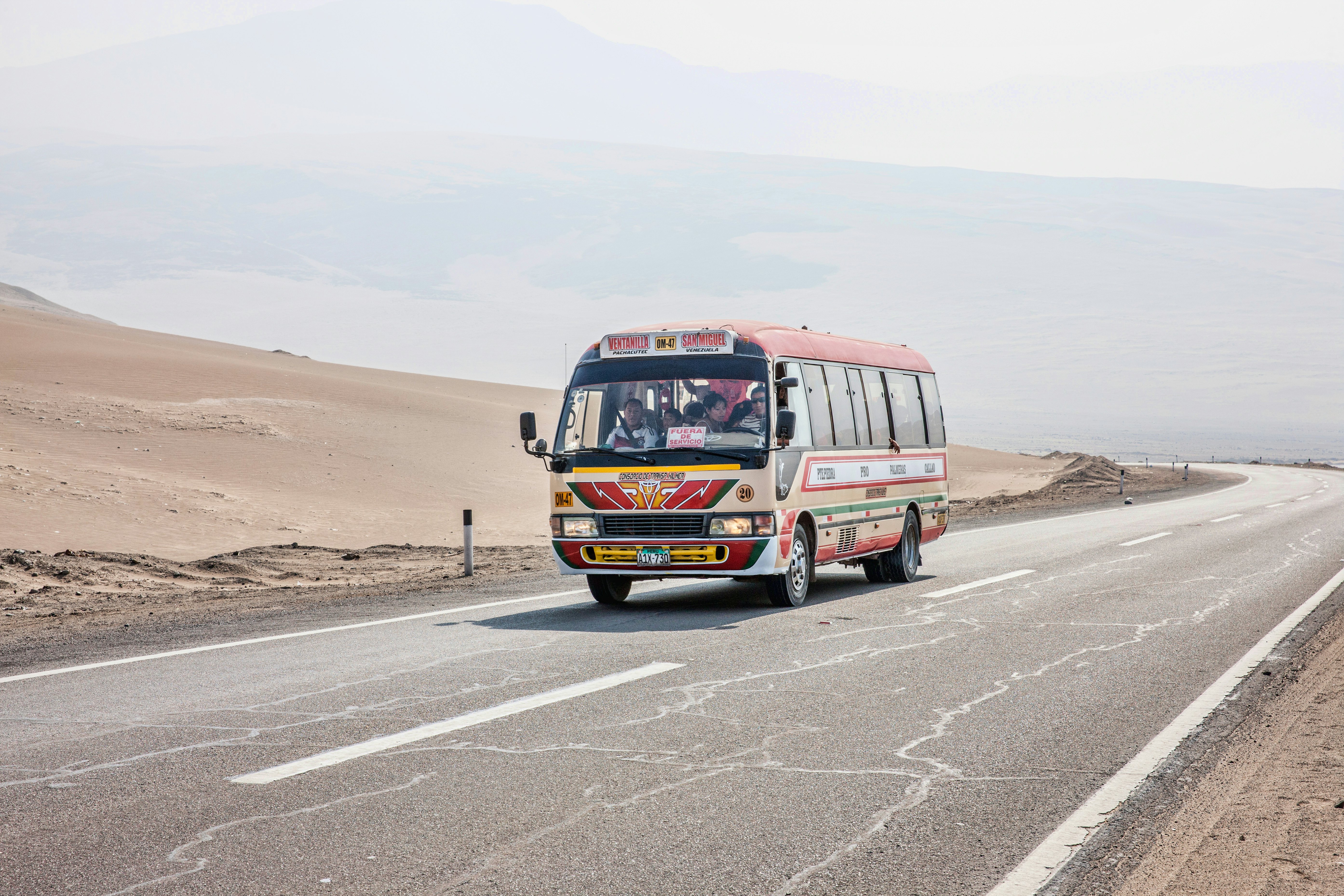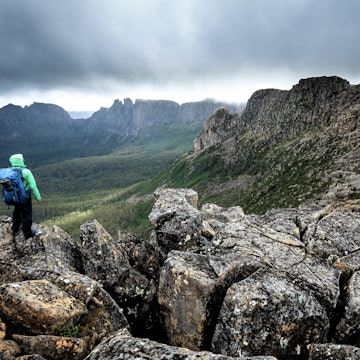

Lima, Peru. Christian Vinces/Shutterstock
Squashed between the Pacific Coast and Amazon Rainforest, with the Andes Mountains running down its spine, Peru is a patchwork of contrasting regions, each with its own unique landscapes and ecosystems.
While this geography makes Peru an exciting country to visit, it also makes it a challenging one to navigate. Paved roads between regions are often absent, the railway network is sparse, and most flights require a connection through Lima, the capital city.
But don’t let the logistics discourage you – exploring this country is a real adventure and worth every minute of extra planning. Here’s our guide to getting around Peru.

Public transport options are complicated
Most travelers arrive in Peru via Lima’s Jorge Chávez International Airport. They are then quickly introduced to the country's public transport as micros (buses) and combis (vans) barrel down the avenues and residential streets of the capital.
Public transport in Peru is a developing service. Hence, there are some road safety concerns (erratic driving and speeding top the list), as well as seemingly little organization – you’ll be hard-pressed to find a set schedule. However, it is an extremely cheap and easy way to get around.
In metropolitan cities such as Lima, Arequipa, Cuzco, and Trujillo, passengers can commute by bus to the other side of the city for less than 4 Peruvian sol (S4). With constant drop-offs and pick-ups, however, travelers should not expect a swift arrival to their final destination.
For example, a 40km (25-mile) bus ride from Comas district in the north end of Lima to Chorrillos in the south can take around two hours.
For an exceptionally local (albeit nail-biting) experience, combis are fast-driving, overly-packed vans that turn into discos at night, blaring reggaeton and illuminating the streets with their fluorescent lights.
There is no set schedule for micros or combis, and the routes are not readily available online, so ask locals waiting at the bus stop for timing and destination details. Alternatively, the cobrador (the person who assists the driver by receiving each passenger’s fare) can tell you where to get off.
Picking the best bus company is key
For longer, interregional routes, various companies offer organized coach services. This is one of the most economical ways to get around Peru. But do your research; not all services are created equal.
One of the most reputable bus companies in Peru is Peru Hop, which caters to tourists rather than local families and business travelers. The service allows passengers to hop on and off along the route, with travelers deciding how much time they want to spend at each destination before continuing their journey. Keep in mind that the bus routes are largely limited to the south of Peru.
If you’re itching to head up north to the beaches of Máncora (15 hours by bus from Lima), the quaint jungle town of Oxapampa (10 hours), or perhaps towards Huaraz (8 hours) to trek the Andes, recommended bus companies include Cruz del Sur, Oltursa and Movil Tours.
Tip for traveling around the highlands: Buses can be significantly delayed during the rainy season (January to April), particularly in the highlands and the jungle.

Meet your new travel partner
Unlimited data while you travel with Holafly eSIM. Use code LONELYPLANET for an exclusive discount.

Getting around by car isn't cheap but gives you options
Getting around Peru by private car is a real adventure, but should only be undertaken by those with time on their side, a forgiving budget, and the ability to be unfazed by the chaotic traffic.
Running north and south, the most important highway in Peru is the Carretera Panamericana, part of the Americas' Pan-American highway.
Long stretches of the coastal desert can become mundane at times but look forward to stopping for a fresh-out-of-the-oven pan a la leña (fresh bread) when heading south, or discovering a secluded beach en route north.
Rental cars are not cheap in Peru, so they are more suited to a 2- or 3-day mini trip than a complete tour of the country. When renting a car – especially if heading towards the jungle or Andes – opt for a model with 4WD due to the rough terrain.
Taxis and moto-taxis are a cheap and cheerful option in the city
Taxis can move you from place to place within a city or town quickly and relatively cheaply. Just be sure to ask locals about standard pricing so as not to pay the “foreigner's special” (an unjustly expensive fare for tourists).
Lima is by far the most expensive city in Peru for transportation – and most things, in fact – but compared to the US and Europe, taxis are incredibly cheap and an average fare usually costs no more than 4 American dollars (US$4).
Taxis in major cities can be waved down on the street or, for greater safety and consistent pricing, ordered through a rideshare app such as Uber (available in Arequipa, Cusco, and Lima).
In the case of the smaller jungle and highland towns, moto-taxis replace the conventional offering and are far cheaper.
Spotting a throng of these moto-taxis (Peru's answer to Thailand's tuk-tuks) when arriving somewhere is a great sign that the place has yet to be gentrified. Most rides will cost no more than S$4.

Enjoy world-class scenic views from the train
The train only serves a handful of destinations within Peru, but the landscapes along these routes are so impressive that they're arguably worth dictating an itinerary around.
The most famous (and popular) train ride in Peru is the scenic journey to the Inca citadel, Machu Picchu. Departing from Cusco or the Sacred Valley town of Ollantaytambo, passengers can take in views of the Vilcanota River and watch verdant valley hills begin to mix with the Amazon Rainforest upon nearing the final stop, Aguas Calientes.
From here it’s a 30-minute bus ride to the Unesco World Heritage Site. The two rail companies for this route are PeruRail and Inca Rail, both offering various price points and levels of comfort.
For those looking to savor every transition in Peru's geography, PeruRail’s Andean Explorer offers luxury sleeper trains between Cusco and Puno (for a picturesque commute to Lake Titicaca), as well as a Cusco-Puno-Arequipa route that brings passengers to the Ciudad Blanca (White City).
Operating since 1999, yet unknown to many visitors, the Ferrocarril Central Andino is an exceptionally thrilling ride – in fact, it once laid claim to being the world’s highest train route. Connecting Lima to Huancayo, a town in the central Peruvian Andes, the train reaches a height of 4782m (15,689ft) above sea level as it climbs through the mountain range.
Clocking in at about 12 hours, plan this railway experience ahead of time as the train operates just once or twice per month.
Move between regions quickly by air
Besides buses, planes are one of the most common and efficient ways for travelers to visit all regions of Peru. The main airline in Peru is LatAm, operating internationally as well as in major national cities.
Small domestic airlines offer cheaper prices but have limited dates. StarPerú only offers flights to Cajamarca, Huanuco, Iquitos, Lima, Pucallpa, and Tarapoto, for example.
The greatest setback of flying in Peru? Most flights between cities other than Lima are not direct and will have to make a connection in the capital city.
While planes are a convenient way to get from A to B for those low on time, they lack the atmosphere travelers can find on Peru’s long-distance bus or train rides. They’re also much more harmful to the environment.
Tip for arriving in Peru: Many international flights arrive in the wee hours – jet-lagged travelers would be wise to book a nearby hotel in advance. Fast and safe, Airport Express has an hourly shuttle service with seven stops throughout Miraflores. There's no bag limit and it has free Wi-Fi, USB chargers and restrooms on board.

Accessible travel in Peru
Peru has a long way to go in terms of inclusive access and accommodations for travelers with mobility issues. Lima has built new infrastructure in recent years, with ramps and elevators becoming more common in places like shopping centers.
However, basics such as smooth, wide sidewalks, signs in braille and phones for the hearing impaired are few and (very) far between. In other regions and provinces, they are completely non-existent.
Within Lima, the light rail does have wheelchair access and fellow passengers are obliged by law to give preferential access to those who are disabled. It's a smooth ride that consists of 26 stops around the city.
Useful resources for disabled travelers in Peru include Conadis, a government agency offering information and advocacy for people with disabilities in the country, and Apumayo Expediciones, one of a handful of adventure-tour companies that runs trips for travelers with mobility issues to Machu Picchu and other historic sites in the Sacred Valley.

Plan with a local
Experience the real PeruLet a local expert craft your dream trip.














